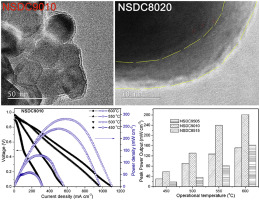Journal of Power Sources ( IF 9.2 ) Pub Date : 2018-03-21 , DOI: 10.1016/j.jpowsour.2018.03.035 Guanghong Zhang , Wenjian Li , Wen Huang , Zhiqun Cao , Kang Shao , Fengjiao Li , Chaoyun Tang , Cuihua Li , Chuanxin He , Qianling Zhang , Liangdong Fan

|
Highly conductive ceria-carbonate composite represents one type of most promising electrolyte materials for low temperature solid oxide fuel cells (SOFCs). Composites with large oxide-carbonate interface and homogeneous element/phase distribution are desirable to further enhance electrical properties and to study the ionic conduction mechanism. In this work, we report the successful synthesis of element/phase well-distributed, interfacial strongly coupled Sm0.2Ce0.8O2-Na2CO3 (NSDC) nanocomposite with different residual carbonate contents by an in-situ one-pot one-step citric acid-nitrate combustion method. Interestingly, NSDC shows distinct properties over those prepared by conventional methods and improved ionic conductivity. In particular, NSDC9010 nanocomposite displays a proton conductivity of 0.044 S cm−1 at 650 °C, which is 3–5 times higher than the oxide proton conductors. Electrolyte supported SOFCs based on the resultant nanocomposite electrolyte, NSDC9010, give the best power output of 281.5 mW cm−2 at 600 °C with LiNiO2 symmetric electro-catalysts. The excellent ionic conductivity and fuel cell performance are correlated with the unique core-shell structure, good phase distribution and large interfacial area induced by the one-step fabrication method, the strong coupling between oxide and carbonate as verified by the differential thermal and Raman spectroscopy characterization results and the optimal interfacial carbonate layer thickness by intentionally adjusting of carbonate contents.
中文翻译:

用于低温固体氧化物燃料电池的强耦合Sm 0.2 Ce 0.8 O 2 -Na 2 CO 3纳米复合材料:一步合成和超界面质子传导
高导电性的二氧化铈-碳酸盐复合材料代表了一种最有前景的用于低温固体氧化物燃料电池(SOFC)的电解质材料。具有大的氧化物-碳酸盐界面和均质的元素/相分布的复合材料对于进一步增强电性能和研究离子传导机理是理想的。在这项工作中,我们报告了元素/相分布良好,界面强耦合的Sm 0.2 Ce 0.8 O 2 -Na 2 CO 3的成功合成(NSDC)纳米复合材料具有不同的残留碳酸盐含量,采用原位一锅法一步一步柠檬酸-硝酸盐燃烧方法。有趣的是,NSDC与常规方法相比具有独特的性能,并具有改善的离子电导率。特别是,NSDC9010纳米复合材料在650°C下的质子电导率为0.044 S cm -1,是氧化物质子导体的3-5倍。基于所得的纳米复合电解质NSDC9010的电解质支持的SOFC,在600°C的条件下,使用LiNiO 2可获得281.5 mW cm -2的最佳功率输出对称的电催化剂。优异的离子电导率和燃料电池性能与一步法制造方法产生的独特核壳结构,良好的相分布和较大的界面面积以及通过差示热和拉曼光谱法验证的氧化物和碳酸盐之间的强耦合有关通过有意地调整碳酸盐含量,可以得到表征结果和最佳的界面碳酸盐层厚度。


























 京公网安备 11010802027423号
京公网安备 11010802027423号